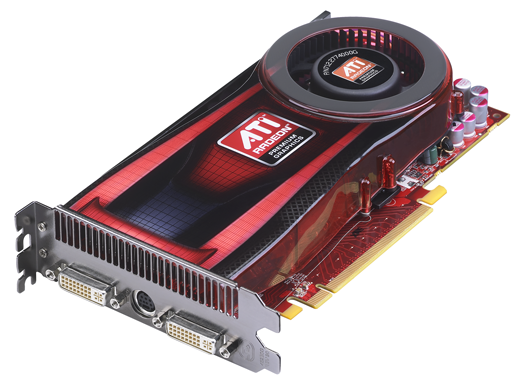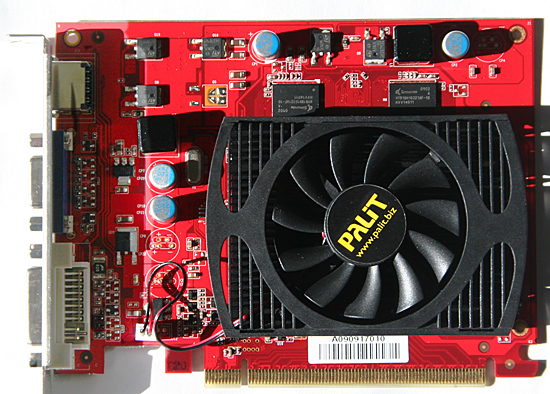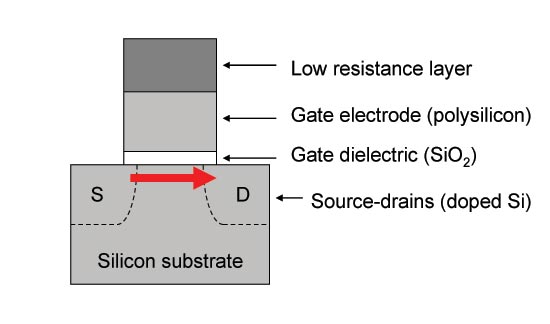The RV870 Story: AMD Showing up to the Fight
by Anand Lal Shimpi on February 14, 2010 12:00 AM EST- Posted in
- GPUs
The Payoff: How RV740 Saved Cypress
For its first 40nm GPU, ATI chose the biggest die that made sense in its roadmap. That was the RV740 (Radeon HD 4770):

The first to 40nm - The ATI Radeon HD 4770, April 2009
NVIDIA however picked a smaller die. While the RV740 was a 137mm2 GPU, NVIDIA’s first 40nm parts were the G210 and GT220 which measured 57mm2 and 100mm2. The G210 and GT220 were OEM-only for the first months of their life, and I’m guessing the G210 made up a good percentage of those orders. Note that it wasn’t until the release of the GeForce GT 240 that NVIDIA made a 40nm die equal in size to the RV740. The GT 240 came out in November 2009, while the Radeon HD 4770 (RV740) debuted in April 2009 - 7 months earlier.

NVIDIA's first 40nm GPUs shipped in July 2009
When it came time for both ATI and NVIDIA to move their high performance GPUs to 40nm, ATI had more experience and exposure to the big die problems with TSMC’s process.
David Wang, ATI’s VP of Graphics Engineering at the time, had concerns about TSMC’s 40nm process that he voiced to Carrell early on in the RV740 design process. David was worried that the metal handling in the fabrication process might lead to via quality issues. Vias are tiny connections between the different metal layers on a chip, and the thinking was that the via failure rate at 40nm was high enough to impact the yield of the process. Even if the vias wouldn’t fail completely, the quality of the via would degrade the signal going through the via.
The second cause for concern with TSMC’s 40nm process was about variation in transistor dimensions. There are thousands of dimensions in semiconductor design that you have to worry about. And as with any sort of manufacturing, there’s variance in many if not all of those dimensions from chip to chip. David was particularly worried about manufacturing variation in transistor channel length. He was worried that the tolerances ATI were given might not be met.

A standard CMOS transistor. Its dimensions are usually known to fairly tight tolerances.
TSMC led ATI to believe that the variation in channel length was going to be relatively small. Carrell and crew were nervous, but there’s nothing that could be done.
The problem with vias was easy (but costly) to get around. David Wang decided to double up on vias with the RV740. At any point in the design where there was a via that connected two metal layers, the RV740 called for two. It made the chip bigger, but it’s better than having chips that wouldn’t work. The issue of channel length variation however, had no immediate solution - it was a worry of theirs, but perhaps an irrational fear.
TSMC went off to fab the initial RV740s. When the chips came back, they were running hotter than ATI expected them to run. They were also leaking more current than ATI expected.
Engineering went to work, tearing the chips apart, looking at them one by one. It didn’t take long to figure out that transistor channel length varied much more than the initial tolerance specs. If you get a certain degree of channel length variance some parts will run slower than expected, while others would leak tons of current.
Engineering eventually figured a way to fix most of the leakage problem through some changes to the RV740 design. The performance was still a problem and the RV740 was mostly lost as a product because of the length of time it took to fix all of this stuff. But it served a much larger role within ATI. It was the pipe cleaner product that paved the way for Cypress and the rest of the Evergreen line.
As for how all of this applies to NVIDIA, it’s impossible to say for sure. But the rumors all seem to support that NVIDIA simply didn’t have the 40nm experience that ATI did. Last December NVIDIA spoke out against TSMC and called for nearly zero via defects.
The rumors surrounding Fermi also point at the same problems ATI encountered with the RV740. Low yields, the chips run hotter than expected, and the clock speeds are lower than their original targets. Granted we haven’t seen any GF100s ship yet, so we don’t know any of it for sure.
When I asked why it was so late with Fermi/GF100, NVIDIA pointed to parts of the architecture - not manufacturing. Of course, I was talking to an architect at the time. If Fermi/GF100 was indeed NVIDIA’s learning experience for TSMC’s 40nm I’d expect that its successor would go much smoother.
It’s not that TSMC doesn’t know how to run a foundry, but perhaps the company made a bigger jump than it should have with the move to 40nm:
| Process | 150nm | 130nm | 110nm | 90nm | 80nm | 65nm | 55nm | 40nm |
| Linear Scaling | - | 0.866 | 0.846 | 0.818 | 0.888 | 0.812 | 0.846 | 0.727 |
You’ll remember that during the Cypress discussion, Carrell was convinced that TSMC’s 40nm process wouldn’t be as cheap as it was being positioned as. Yet very few others, whether at ATI or NVIDIA, seemed to believe the same. I asked Carrell why that was, why he was able to know what many others didn’t.
Carrell chalked it up to experience and recounted a bunch of stuff that I can’t publish here. Needless to say, he was more skeptical of TSMC’s ability to deliver what it was promising at 40nm. And it never hurts to have a pragmatic skeptic on board.










132 Comments
View All Comments
Dudler - Sunday, February 14, 2010 - link
Your reasoning is wrong. The 57xx is a performance segment down from the 48xx segment. By your reasoning the 5450 should be quicker than the last gen 4870X2. The 5870 should be compared to the 4870, the 5850 to 4850 and so on.Regarding price, the article sure covers it, the 40nm process was more expensive than TSMC told Amd, and the yield problems factored in too. Can't blame Amd for that can we?
And finally, don't count out that Fermi is absent to the party. Amd can charge higher prices when there is no competition. At the moment, the 5-series has a more or less monopoly in the market. Considering this, I find their prices quite fair. Don't forget nVidia launched their Gtx280 at $637....
JimmiG - Friday, February 19, 2010 - link
"Your reasoning is wrong. The 57xx is a performance segment down from the 48xx segment. "Well I compared the cards across generations based on price both at launch and how the price developed over time. The 5850 and 4850 are not in the same price segment of their respective generation. The 4850 launched at $199, the 5850 at $259 but quickly climbed to $299.
The 5770 launched at $159 and is now at $169, which is about the same as a 1GB 4870, which will perform better in DX9 and DX10. Model numbers are arbitrary and at the very best only useful for comparing cards within the same generation.
The 5k-series provide a lot of things, but certainly not value. This is the generation to skip unless you badly want to be the first to get DX11 or you're running a really old GPU.
just4U - Tuesday, February 16, 2010 - link
and they are still selling the 275,285 etc for a hefty chunk of change. I've often considered purchasing one but the price has never been right and mail in rebates are a "PASS" or "NO THANKS" for many of us rather then a incentive.I haven't seen the mail-ins for AMD products much I hope their reading this and shy away from that sort of sales format. To many of us get the shaft and never recieve our rebates anyway.
BelardA - Monday, February 15, 2010 - link
Also remind people... the current GTX 285 is about $400 and usually slower than the $300 5850. So ATI is NOT riping off people with their new DX11 products. And looking at the die-size drawings, the RV870 is a bit smaller than the GT200... and we all now that FERMI is going to be another HUGE chip.The only disappointment is that the 5750 & 5770 are not faster than the 4850/70 which used to cost about $100~120 when inventory was good. Considering that the 5700 series GPUs are smaller... Hell, even the 4770 is faster than the 5670 and costs less. Hopefully this is just the cost of production.
But I think once the 5670 is down to $80~90 and the 5700s are $100~125 - they will be more popular.
coldpower27 - Monday, February 15, 2010 - link
nVidia made a conscious decision, not to fight the 5800 Series, with the GTX 200 in terms of a price war. Hence why their price remain poor value. They won't win using a large Gt200b die vs the 5800 smaller die.Another note to keep in mind is that the 5700 Series, also have the detriment of being higher in price due to ATi moving the pricing scale backup a bit with the 5800 Series.
I guess a card that draws much less power then the 4800's, and is close to the performance of those cards is a decent win, just not completely amazing.
MonkeyPaw - Sunday, February 14, 2010 - link
Actually, the 4770 series was meant to be a suitable performance replacement for the 3870. By that scheme, the 5770 should have been comperable to the 4870. I think we just hit some diminishing returns from the 128bit GDDR5 bus.nafhan - Sunday, February 14, 2010 - link
It's the shaders not the buswidth. Bandwidth is bandwidth however you accomplish it. The rv8xx shaders are slightly less powerful on one to one basis than the rv7xx shaders are.LtGoonRush - Sunday, February 14, 2010 - link
The point is that an R5770 has 128-bit GDDR5, compared to an R4870's 256-bit GDDR5. Memory clock speeds can't scale to make up the difference from cutting the memory bus in half, so overall the card is slower, even though it has higher compute performance on the GPU. The GPU just isn't getting data from the memory fast enough.Targon - Monday, February 15, 2010 - link
But you still have the issue of the 4870 being the high end from its generation, and trying to compare it to a mid-range card in the current generation. It generally takes more than one generation before the mid range of the new generation is able to beat the high end cards from a previous generation in terms of overall performance.At this point, I think the 5830 is what competes with the 4870, or is it the 4890? In either case, it will take until the 6000 or 7000 series before we see a $100 card able to beat a 4890.
coldpower27 - Monday, February 15, 2010 - link
Yeah we haven't seen ATi/nVidia achieved the current gen mainstream faster then the last gen high end. Bandwidth issues are finally becoming apparent.6600 GT > 5950 Ultra.
7600 GT > 6800 Ultra.
But the 8600 GTS, was only marginally faster then the 7600 GT and nowhere near 7900 GTX, it took the 8800 GTS 640 to beat the 7900 GTX completely, and the 800 GTS 320 beat it, in the large majority of scenarios, due to frame buffer limitation.
The 4770 slots somewhere between the 4830/4850. However, that card was way later then most of the 4000 series. Making it a decent bit faster then the 3870, which made more sense since the jump from 3870 to 4870 was huge, sometimes nearly even 2.5x could be seen nearly, given the right conditions.
4670 was the mainstream variant and it was, most of the performance of the 3800 Series, it doesn't beat it though, more like trades blows or is slower in general.